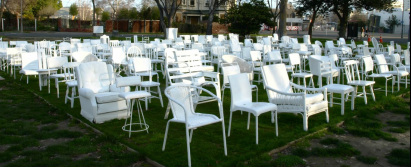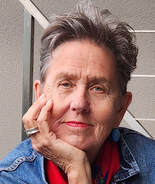A crane nibbled delicately, like a giant praying mantis, on the remnants of a teetering office block while a bulldozer ground its way over mountains of rubble, shoving broken concrete and twisted steel into separate heaps. Even the undamaged buildings looked naked and vulnerable standing alone in fields of brick-dust and weeds.

We passed a man on a tractor in a field, a woman standing at a letterbox. We drove by dilapidated farm sheds clinging miraculously to verticality and new low-slung modernist milking sheds. A paddock full of Friesian calves looked like baize scattered with black and white jigsaw puzzle pieces.
We were almost the only car on the road. The other vehicles were freight trucks, milk tankers, and camper vans with cheerful names like Fairwinds, Trailbrite and Easy Go. In Murchison, the soldier statue on the war memorial stood on his plinth in lemon-squeezer hat and puttees, head bowed and hands folded over his rifle butt.
Everywhere, on seemingly blameless stretches of road there were white crosses adorned with plastic flowers. Near Christchurch, the sky darkened and it began to rain.
Absurdly, the tune of a song from “My Fair Lady” swam into my head and then the lyrics:
I have often walked down this street before
But the pavement’s always stayed beneath my feet before.
Christchurch certainly has a soundtrack, but it’s not a Broadway tune. It’s an inescapable ceaseless pounding, rumbling cacophony as men and heavy machines demolish and repair and rebuild.
Something baulks and refuses to comprehend destruction on a grand scale. You feel dizzy and disoriented when familiar buildings have vanished or look completely different – even the cathedral doesn’t look like a cathedral now that it has no steeple.
And so I found myself fixing on the small details, not the large: the leaves which the wind has piled up against the sealed doors of the public library; pretty tiles which someone has tried to protect by covering them in plastic sheeting and duct tape; the hand-painted picture of a broken heart in the window of an abandoned apartment, a photocopier lying on its back on the pavement with its legs in the air.
Or I looked for signs of hope: the raised hand and spread wings of an unbroken statue in front of the cathedral, the murals and other artworks which have sprung up since the quakes; three men in hi-viz vests conferring on the street, two of them holding clipboards, the third holding a cat under his arm.
We stay the night with a friend in his house about 5 kms from the city centre. The old and new parts of his house have broken away from each other but the place is still liveable, although the fences lean, the driveway is twisted and a retaining wall threatens to topple into the street. The government department he works for lost its building during the earthquake and so for the last two years, he and two of his colleagues have worked from his home: his sitting room is their office; his kitchen is their tearoom. They arrived as I as was eating my breakfast, sat down at their computers, took up their phones, and set to work.
After breakfast, I went for a walk in South Hagley Park where a tractor trawled sedately back and forth dragging a mower. Sprinklers flung arcs of water into the sunlit air. High school kids lolly-gagged their way to the sports fields. Men and women with briefcases marched purposefully to work. A young mother pushed twins in a buggy. Cyclists and joggers puffed past me was I wandered in the cool green shadow of the old oaks which edge the park. The grass was lush and scattered with small white daisies.
Except for the crump and thrum and rumble of heavy machinery, everything seemed so normal that it’s tempting to see this as evidence of the city’s resilience and renewal. But that’s too glib. The people of Christchurch have no choice but to go on living through what’s happened to their homes, their workplaces, their church halls, schools, pubs, and local shops. They are being heroic because they can’t do anything else but put one tired and dispirited foot after the other.
It’s a guilty relief to be able to leave the city the next morning, to be in open country again under a quiet, open sky. The image of Christchurch that stays in my mind is not of broken buildings and roads but of an art installation in Madras Street.
One hundred and eighty-five white-painted chairs - kitchen chairs, lounge chairs, office chairs - standing on a square of green turf: one chair for each person who died in the earthquake.
 RSS Feed
RSS Feed

